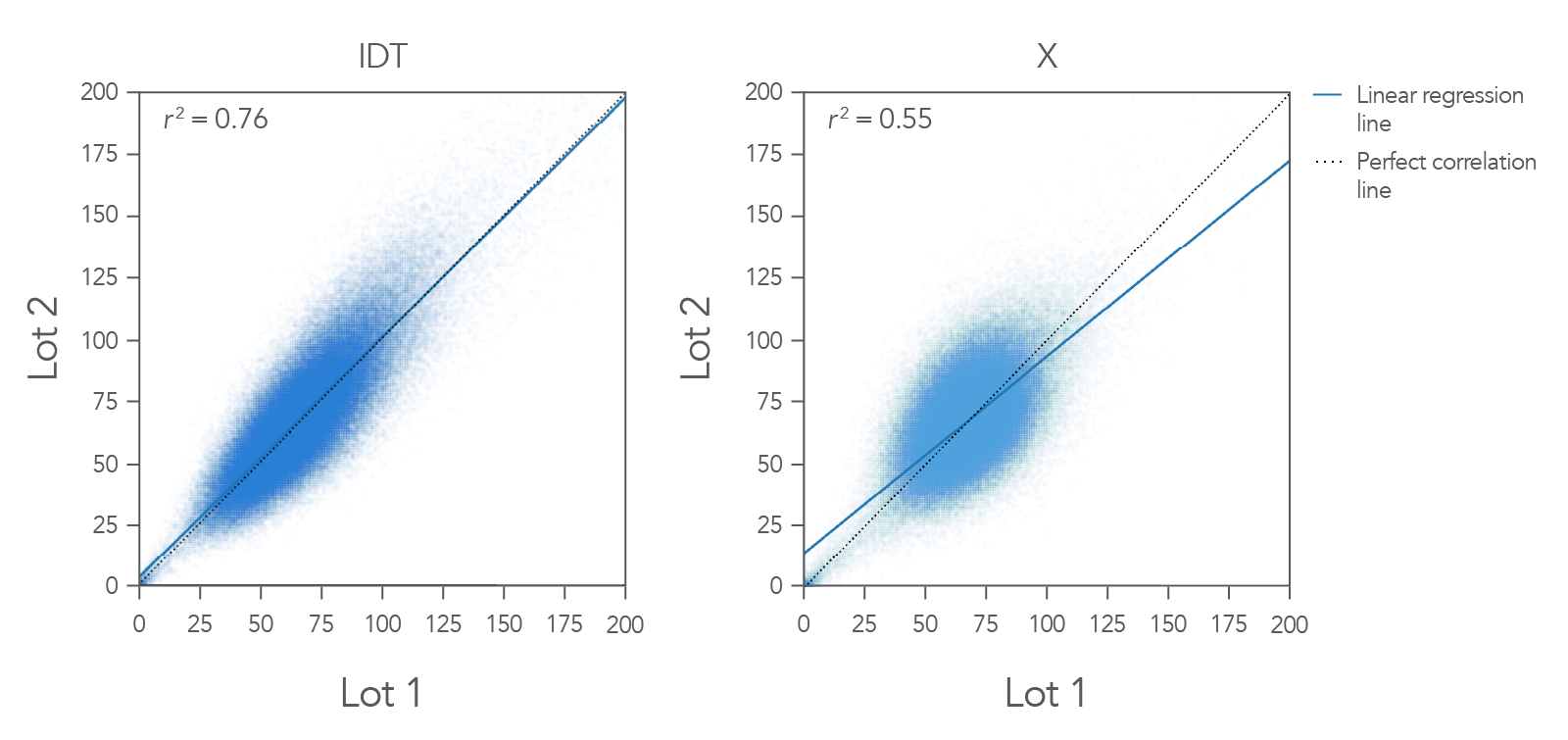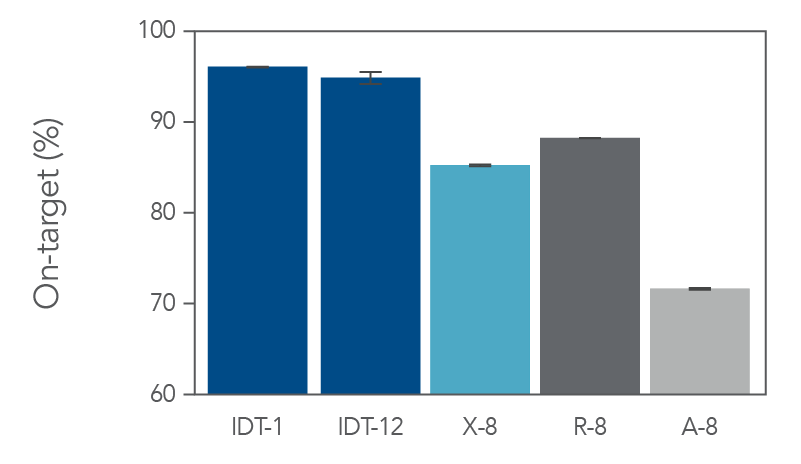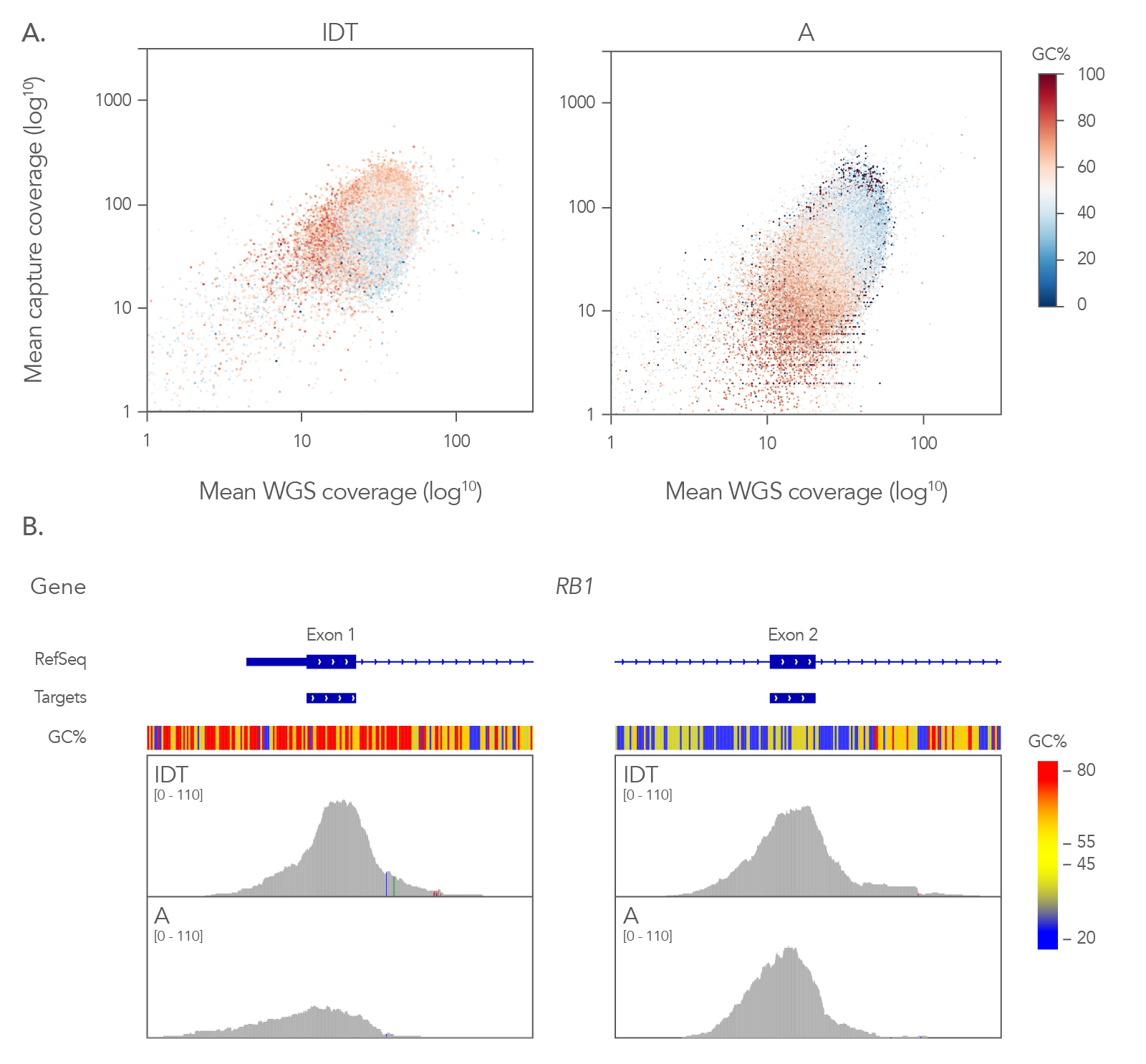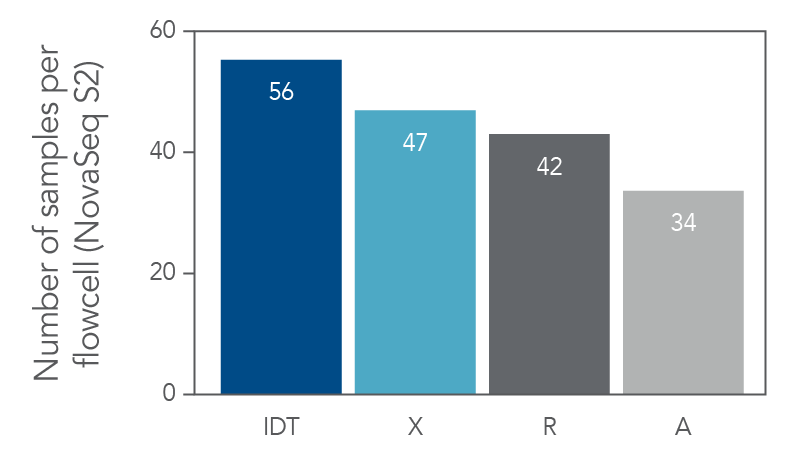xGen Exome Research Panel v2
Go ahead and commit. We made a lot.
We designed this updated panel using our new target-aware algorithm, resulting in the most complete coverage of any exome panel on the market. We assessed each probe with proprietary off-target analysis and manufactured them under strict ISO 13485 standards. We performed electrospray ionization mass spectrometry (ESI-MS) and dual quantification on each of the 415,115 probes before pooling. Finally, individual probe synthesis means we can deliver on a much larger scale than array methods, and produce a single large lot that can be aliquoted and stored securely, for years of reproducibility.
The xGen Exome Research Panel v2 gives you the confidence that only individual probe synthesis and individual QC can provide, and it comes at a price that makes your choice easy.
- The new standard for exome coverage
- Consistent performance through time
- Infinite possibilities for customization
- Time and cost savings
Ordering
Interested in a volume discount? Contact us.
For customers who wish to purchase the legacy xGen Exome Research Panel v1.0, please contact us today.
Product details
Exome sequencing sequences only the protein-coding regions of the genome. Since exons represent only 1% of the human genome, an effective method of separating these regions from noncoding DNA is critical to focus on potentially important mutations implicated in disease. The captured material must also be suitable for sequencing to a satisfactory depth of coverage for reliable detection of variant alleles and sensitive applications like copy number variation (CNV) detection. To provide increased depth of coverage and enable high multiplexing of samples, the xGen Exome Research Panel v2 targets only the coding sequences (CDS) of human coding genes in the RefSeq 109 database.
xGen Exome Research Panel v2 consists of 5′ biotin–modified oligonucleotide probes that are individually synthesized and individually analyzed by ESI-MS and optical density (OD) measurement. The probes are normalized before pooling to ensure that each probe is represented in the panel at the correct concentration. Probes that fail quality control are resynthesized. This rigorous manufacturing process gives xGen Exome Research Panel v2 a unique advantage over array-derived pools in which missing or truncated probes cannot be identified before sequencing. IDT proprietary synthesis methods enable challenging probes, such as those with high GC and AT content, to be appropriately represented in the panel. The individual probes are synthesized on a larger scale than that which is available for array manufacturing, allowing IDT to produce a single, large lot of material that is aliquoted over time, providing consistent results for years.
xGen Exome Research Panel v2 consists of 415,115 individually synthesized and quality controlled xGen Lockdown Probes. The panel spans a 34 Mb target region (19,433 genes) of the human genome and covers 39 Mb of probe space, the genomic regions covered by probes. Probes were designed using our new “capture-aware” algorithm and assessed with proprietary off-target analysis, ensuring the most complete design coverage. All probes in the panel are manufactured under strict ISO 13485 standards. Mass spectrometry and dual quantification measurements of each probe ensure the quality of the probe and its appropriate representation in the pool.
Performance
Consistent data—don't waste time troubleshooting lots
Our lots last years not months.
Figure 1. Limit expensive revalidation by having a single, large lot. 100 ng DNA was used to make libraries, which were captured in 8-plex. Two different users performed the captures on different days in different locations. The IDT xGen Exome Research Panel v2 shows a linear regression line that mimics the predicted “perfect” correlation line with an R2 value of 0.76. In comparison, 2 lots of supplier X showed significantly less consistency and indicate more lot-to-lot variation, which may require more detailed re-validation.
Superior on-target coverage and uniformity
Figure 2. The IDT xGen Exome Research Panel v2 outperforms other vendors for efficiency of capture. Sequencing libraries were prepared using enzymatic shearing and ligation-based library preparation using the library prep from each vendor. Libraries were captured and multiplexed according to the vendor’s exome panel capture protocol (X-8, R-8, and A-8, where 8 signifies 8-plex captures). For IDT, we show both 1-plex and 12-plex captures (IDT-1 and IDT-12, respectively). Enriched libraries were sequenced on a NextSeq® instrument (Illumina) in high output mode using 2x100 paired-end reads. On-target bases were determined with Picard (percent selected bases) using 5 Gb per library.
Figure 3. Highly uniform sequence coverage with xGen Exome Research Panel v2 leads to lower sequencing costs. DNA libraries were created from 100 ng of human genomic DNA (Coriell) using xGen Stubby Adapter and Unique Dual Index Primer Pairs with the Lotus DNA Library Prep Kit. These libraries were enriched either as 1-plex captures or in a single 12-plex capture using the xGen Exome Research Panel v2. The enriched libraries were sequenced (2x100) on a NextSeq® instrument (Illumina) and subsampled to 5 Gb. The data shows deep, uniform coverage with a flanked on-target rate of 94.7%, mean target coverage of 64.5X, and a duplication rate of 3.3% (calculated with Picard).
Excellent coverage of RefSeq database with minimal sequencing
Figure 4. Coverage profile of xGen Exome Research Panel v2 most closely resembles whole genome data. (A) A comparison of coverage depths of different exome panels to coverage depth from whole genome sequencing (WGS) of a matched library shows that the xGen Exome Research Panel v2 provides the closest match to WGS. Analysis of GC content shows that the higher coverage of the xGen panel is driven by the more effective capture of GC content. (B) RB1 exons 1 and 2 show extremes of GC content with ~76% in exon 1 and ~38% in exon 2. A comparison of capture between IDT and supplier A shows uniform, complete coverage for xGen Exome Research Panel v2 on the Integrative Genomics Viewer (Broad Institute), whereas supplier A struggles with GC content differences.
Figure 5. The most complete exome coverage is achieved with the xGen Exome Research Panel v2. (A) Enriched libraries were sequenced with 5 Gb per samples and the percent of exons covered end-to-end at each read depth were calculated. xGen Exome Research Panel v2 (IDT) shows the highest percentage of exons covered at each indicated depth (compared to suppliers X, R, and A). (B) The xGen Exome Research Panel v2 provides the most complete end-to-end gene coverage at ≥20X. Individual samples were subsampled at different read depths (2x100 bp read length). The percentage of genes that were covered for every base of every exon at ≥20X was calculated at each read depth and plotted.
Maximize sequencing efficiency
Figure 6. xGen Exome Research Panel v2 reduces sequencing costs. DNA libraries were created from 100 ng of human genomic DNA (Coriell) using xGen Stubby Adapter and Unique Dual Index I Primer Pairs with the Lotus DNA Library Prep Kit. These libraries were enriched either as 8-plex (suppliers X, R, and A) or 12-plex (IDT) captures. The enriched libraries were sequenced (2x100) on a NextSeq® instrument (Illumina) and the number of reads required to achieve 75X mean target coverage (Picard) per sample was calculated. The number of samples that would fit on a NovaSeq™ S2 flowcell (Illumina) was calculated.
Get the demo data
Demo data is available for your evaluation.


 Processing
Processing








